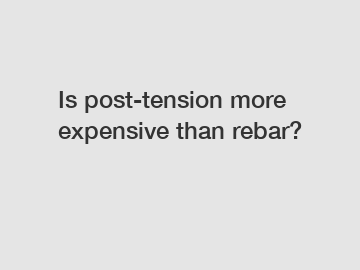Is post-tension more expensive than rebar?
Mar. 22, 2024
When it comes to constructing buildings, bridges, or any other structures, two common methods for reinforcing concrete are post-tensioning and using rebar. Both methods have their advantages and disadvantages, but one common question that arises is which one is more expensive. In this article, we will explore the costs associated with post-tensioning versus using rebar in construction projects.
Post-Tensioning vs. Rebar: An Overview.
Post-tensioning is a method of reinforcing concrete by inserting high-strength steel strands or cables into the concrete and then tightening them to apply compressive stress to the structure. This process allows for thinner concrete slabs and longer spans without the need for additional support columns. On the other hand, rebar, short for reinforcing bar, involves placing steel bars within the concrete to provide tensile strength and prevent cracks.

Now, let's delve into the cost comparison between post-tensioning and rebar:
Cost of Materials.
One of the key factors contributing to the cost of post-tensioning is the high-strength steel strands or cables used in the process. These materials are typically more expensive than traditional rebar. However, post-tensioning allows for more efficient use of materials, as thinner concrete slabs can be used, which may offset the higher material costs.
Rebar, on the other hand, is a more straightforward method that involves placing steel bars within the concrete. While rebar itself is less expensive than post-tensioning materials, the amount of rebar required for a project can drive up costs, especially for structures that require extensive reinforcement.
Labor Costs.
In terms of labor costs, post-tensioning may require specialized labor to install the steel cables and tension them properly. The process of post-tensioning can be more time-consuming and intricate compared to simply placing rebar within the concrete. This specialization may result in higher labor costs for post-tensioning projects.
Rebar, on the other hand, is a more conventional method that may not require as much specialized labor. Placing and securing rebar within concrete is a task that many construction workers are familiar with, potentially leading to lower labor costs for rebar reinforcement.
Engineering and Design Considerations.
Another factor that can influence the cost of post-tensioning versus rebar is the engineering and design considerations for the project. Post-tensioning allows for more flexibility in structural design, as thinner slabs and longer spans can be achieved. However, this increased complexity may require more time and expertise from engineers, potentially adding to the cost of post-tensioning projects.
Rebar, while a simpler method, may still require careful engineering and design to ensure that the concrete structure is properly reinforced. The cost of engineering services and design considerations can vary depending on the complexity of the project and the amount of reinforcement needed.
Conclusion.
In conclusion, the cost of post-tensioning versus using rebar in construction projects can vary depending on several factors such as materials, labor, and engineering/design considerations. While post-tensioning materials may be more expensive than rebar, the efficiency of the method and potential savings in material usage could offset some of the initial costs. Additionally, labor costs and engineering considerations can also impact the overall cost of each method.
Ultimately, the choice between post-tensioning and rebar will depend on the specific requirements of the project, budget constraints, and desired outcomes. It is essential to consult with a knowledgeable contractor or engineer to determine the most cost-effective reinforcement method for your construction project.
Contact us.
If you have any questions about post-tensioning, rebar, or any other construction-related inquiries, please do not hesitate to contact us. Our team of experts is here to help you make informed decisions for your construction projects.
Contact us to discuss your requirements of post tensioning system odm, bulk supply post tension anchor, post tensioning system odm. Our experienced sales team can help you identify the options that best suit your needs.
128
0
0

Comments
All Comments (0)